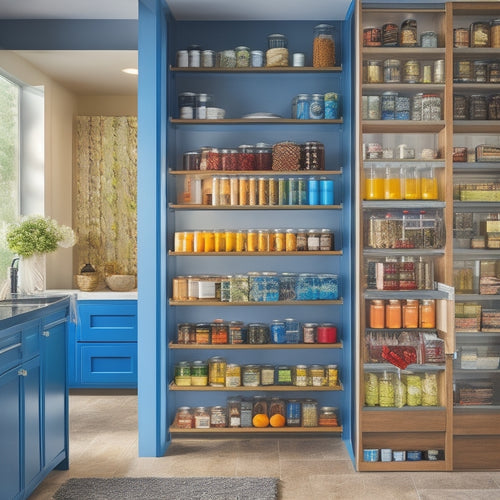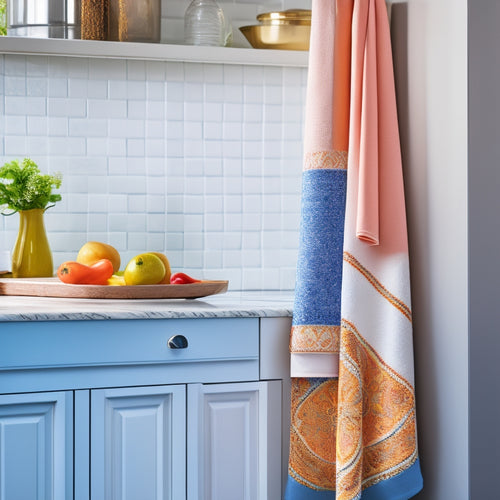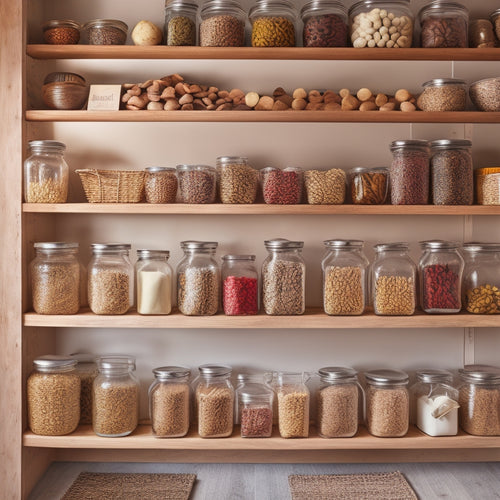
Optimize Your Kitchen for Low-Fat Diet Success
Share
You're beginning the first step towards low-fat diet success by recognizing that your kitchen can either hinder or help you achieve your health goals. Start by evaluating your kitchen's current state, then purge high-fat foods and storage to make way for whole, healthy options. Allocate zones for meal prep, cooking, and storage, and utilize smart storage solutions to keep fresh produce and healthy essentials within easy reach. By streamlining your kitchen, you'll set yourself up for low-fat diet success and stay on track with healthy choices - and that's just the beginning of your journey towards a healthier lifestyle.
Key Takeaways
• Evaluate and declutter your kitchen to create a low-fat friendly environment, removing high-fat foods and condiments.
• Organize your kitchen into functional zones, allocating space for meal prep, cooking, and storage of healthy ingredients.
• Invest in smart storage solutions, labeling healthy options and utilizing vertical space to maximize storage and accessibility.
• Designate a low-fat prep area, equipping it with essential tools and flavor enhancers to support healthy cooking habits.
• Maintain a healthy pantry, regularly restocking with whole foods and low-fat ingredients to stay on track with your diet goals.
Assess Your Kitchen's Current State
Take stock of your kitchen's current layout, contents, and habits to identify areas that may be hindering your ability to prepare and maintain a low-fat diet. Start by evaluating the organization of your kitchen. Are your cooking utensils and ingredients easily accessible, or do you find yourself rummaging through cluttered drawers and cabinets?
Assess how you're using your countertops. Are they cluttered with appliances, cookbooks, and miscellaneous items, or is there ample space to prepare healthy meals? Declutter countertops by designating specific zones for food preparation, cooking, and storage. Consider investing in a utensil organizer or a spice rack to keep frequently used items within reach.
Evaluate your kitchen's workflow and identify areas where you can streamline meal prep. For instance, if you find yourself constantly washing and chopping vegetables, consider investing in a vegetable chopper or a prep sink. By optimizing your kitchen's layout and workflow, you'll set yourself up for success in maintaining a low-fat diet.
Purge High-Fat Food Storage
Now that your kitchen's layout and workflow are optimized, it's time to tackle the pantry and purge high-fat food items that can sabotage your diet. You've set the stage for success, but it's vital to eliminate temptation and create a supportive environment.
Start by removing high-fat condiments, processed snacks, and baked goods from your pantry and fridge. Take everything out and sort items into three categories: keep, donate/sell, and discard. Be ruthless – if it's high in fat, it's got to go.
Consider the 80/20 rule: 80% of the time, you likely use 20% of your pantry staples. Focus on whole, unprocessed foods and healthy staples like oats, quinoa, and canned beans.
As you purge, think about fridge organization and pantry makeover strategies to maximize storage and visibility. This will help you maintain your new pantry and make healthy choices easier.
Assign Zones for Healthy Eating
By designating specific zones for healthy eating, you'll create a kitchen workflow that encourages mindful food preparation and consumption. Divide your kitchen into functional areas, such as a meal planning zone, a healthy swap zone, and a cooking zone.
In the meal planning zone, keep essential tools like a calendar, recipe books, and a meal planning app to help you plan balanced meals and maintain portion control.
In the healthy swap zone, store healthier alternatives to your favorite treats, such as low-fat dairy products, whole-grain crackers, and fresh fruits. This zone will encourage you to make mindful choices when snacking or cooking.
The cooking zone should be equipped with utensils and cookware that promote healthy cooking methods, like steaming, roasting, or grilling.
Smart Storage for Fresh Produce
You'll want to allocate a prominent spot in your kitchen for storing fresh produce, as it's a key component of a low-fat diet and deserves prime real estate. This will encourage you to incorporate more fruits and vegetables into your meal prep, making healthy eating a breeze.
Consider designating a specific area, like a crisper drawer or a countertop basket, to keep your fresh produce within easy reach. This way, you'll be more likely to grab an apple instead of a bag of chips when you need a quick snack.
When you visit the farmers market, you'll want to have a plan in place for storing your fresh finds. Invest in reusable bags or containers to keep your produce fresh and organized. Store delicate items like berries and leafy greens in breathable bags, while heartier produce like apples and carrots can be stored in baskets or bins.
Label and Sign Healthy Options
Clear labels and signs can guide your meal prep decisions, steering you towards healthy options and away from high-fat temptations. By making healthy choices visible, you'll be more likely to stick to your low-fat diet plan. Create nutrition labels for your pantry staples, such as whole grains, lean proteins, and healthy oils, so you can easily identify them.
Here are some ways to increase visibility of healthy options in your kitchen:
-
Create a 'healthy zone' on your countertops, where you display fresh fruits, nuts, and veggies in attractive bowls and baskets.
-
Designate a specific shelf in your pantry for low-fat snacks, such as air-popped popcorn and whole-grain crackers.
-
Use signage to highlight healthy cooking methods, like grilling or roasting, and provide recipes or cooking tips near your cooking stations.
Eliminate Hidden Fat Traps
Now that you've made healthy options more visible, it's time to tackle the hidden fat traps that can sabotage your low-fat diet efforts.
One common trap is relying on high-fat cooking methods like frying and sautéing. To avoid this, focus on fat-free cooking techniques like grilling, roasting, and steaming. These methods not only reduce fat intake but also preserve nutrients in your food.
Another hidden fat trap is using high-fat ingredients in your recipes. Start making low-fat ingredient swaps to reduce overall fat content. For example, use low-fat milk instead of whole milk, choose lean protein sources like chicken breast or turkey, and opt for low-fat cheese or vegan alternatives.
You can also replace high-fat condiments like mayonnaise with low-fat alternatives like Greek yogurt or avocado.
Stock Healthy Cooking Essentials
To set yourself up for low-fat cooking success, stock your kitchen with healthy essentials like non-stick cookware, silicone utensils, and a variety of herbs and spices. These must-haves will help you prepare delicious, low-fat meals with ease.
- Olive oil and avocado oil for healthy sautéing
- Fresh lemons and limes for adding flavor without added salt or sugar
- A set of measuring cups and spoons for precise portion control
Proper pantry organization is also essential for low-fat cooking success. By keeping healthy staples, such as whole grains, canned beans, and low-fat dairy products, within easy reach, you'll be more likely to incorporate them into your meals.
Additionally, implementing meal prep strategies, like cooking proteins and vegetables in bulk, can save you time and guarantee that healthy options are always available.
Designate a Low-Fat Prep Area
By designating a specific area of your kitchen as a low-fat prep zone, you'll create a conducive environment that fosters healthy food preparation habits. This zone should be equipped with the essential tools and resources that support your low-fat diet goals. Consider organizing your prep area using a color-coded system, where similar items are grouped together, making it easy to find what you need when you need it.
Here's a sample layout to get you started:
| Zone | Tools and Resources | Benefits |
|---|---|---|
| Recipe Hub | Low-fat recipe books, cooking apps | Access to healthy recipes and inspiration |
| Prep Station | Designated tools (e.g., non-stick pans, utensils) | Efficient food preparation with the right tools |
| Measurement Central | Digital scale, measuring cups and spoons | Accurate measurements for healthy portion control |
| Cooking Corner | Cooking gadgets (e.g., air fryer, slow cooker) | Healthy cooking methods made easy |
Outsmart High-Fat Food Temptations
As you set up your low-fat prep zone, addressing the high-fat foods that may be lurking in your kitchen is crucial, tempting you to stray from your healthy eating goals.
To outsmart these temptations, taking control of your food environment is vital.
Here are some strategies to help you stay on track:
-
Purge high-fat foods: Get rid of processed and high-calorie snacks, and replace them with healthier alternatives. This will help you avoid mindless munching and make healthier choices easier.
-
Use portion control: Even healthy foods can lead to weight gain if consumed in excess. Measure your food portions to make sure you're eating the right amounts.
-
Make healthy swaps: Identify high-fat foods you can't resist and find healthier substitutes. For example, swap mayonnaise for mustard or choose low-fat cheese instead of regular cheese.
Maximize Vertical Storage Space
You can greatly reduce clutter and free up valuable counter space by maximizing your kitchen's vertical storage space. This won't only make your kitchen look more organized, but it will also make it easier to maintain a low-fat diet by keeping healthy cooking essentials within easy reach.
To start, utilize hanging hooks for pots and pans. This will free up cabinet space, allowing you to store more healthy cooking staples like whole grains, lean proteins, and fresh produce.
Consider installing shelves above countertops to store rarely used items, such as special occasion cookware or infrequently used appliances, above eye level. This will keep them out of the way but still accessible when you need them.
Frequently Asked Questions
Can I Still Cook for Family Members With Different Dietary Needs?
You can definitely cook for family members with different dietary needs; consider family accommodations like meal prep, labeling, and shared meal ideas, such as stir-fries or salads, that cater to everyone's requirements.
How Do I Handle Food Cravings for High-Fat Foods?
Like a detective searching for clues, you'll uncover healthy alternatives to high-fat cravings by stocking your pantry with nutritious options and practicing portion control, ensuring you satisfy your cravings without compromising your diet.
Will a Low-Fat Kitchen Lead to a Boring Cooking Routine?
You won't sacrifice flavor for fat reduction; instead, explore flavorful alternatives that spark cooking creativity, ensuring balanced meals with variety in dishes that delight your taste buds and nourish your body.
Can I Convert My Kitchen to Low-Fat on a Limited Budget?
You can convert your kitchen to low-fat on a limited budget by making affordable substitutions, like swapping olive oil for avocado oil, and engaging in creative meal planning that incorporates flavorful spices and herbs.
How Long Does It Take to Adjust to a Low-Fat Kitchen Environment?
'Think of adapting to a low-fat kitchen like training for a marathon - it takes time. Typically, it takes 2-4 weeks to adjust to new habits. Develop coping strategies like meal prep and label reading to ease your adjustment timeline.'
Related Posts
-

Sliding Pantry Organizers With Tiered Racks
Sliding pantry organizers with tiered racks optimize your pantry space and enhance accessibility. These organizers cr...
-

Over-The-Door Kitchen Towel Holder
An over-the-door kitchen towel holder is a smart way to maximize your space while keeping towels easy to grab. It hoo...
-

Innovative Pantry Storage Ideas for Homes
Revamp your pantry into an efficient space with innovative storage solutions. Use vertical storage options like ceili...


